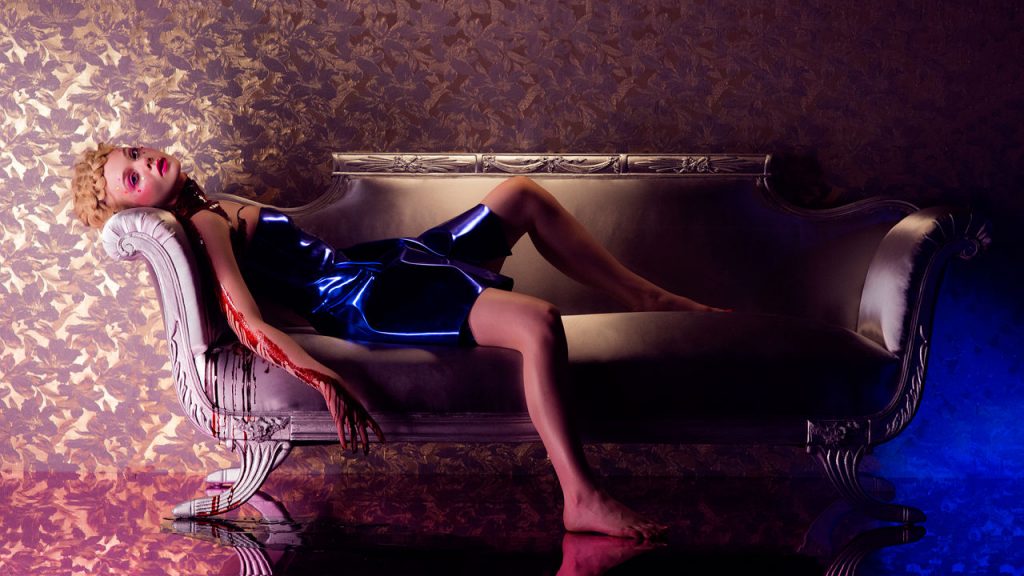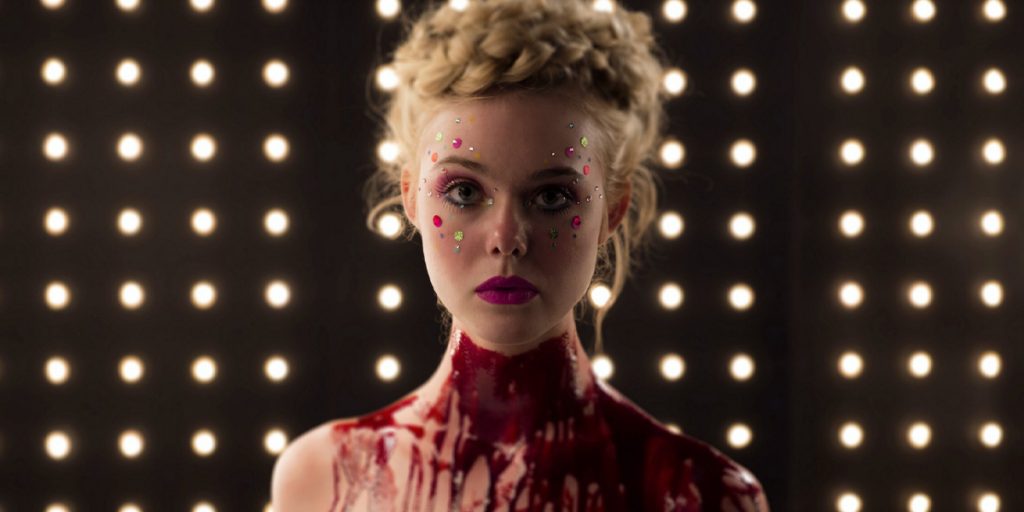With haunting imagery, The Neon Demon meticulously critiques an industry that seems to run on the philosophy that “True beauty is the highest currency we have.”
The Neon Demon is a film that tells the story of sixteen year old Jesse (Elle Fanning), who goes to Los Angeles to be a model. She befriends amateur photographer Dean (Karl Glusman), who does a preliminary but bold photoshoot for her. Using that as portfolio, she gets hired by Roberta Hoffmann (Christina Hendricks), who introduces her to professional photographer Jack (Desmond Harrington). Jack gives her a makeover and an amazing photoshoot, promising to give her a place in his editorial if the photographs come out well, an exception for a first-timer, as Roberta and her other model friends insinuate. Jesse also befriends Ruby (Jena Malone, of Adopting Audrey), who seems overly approachable, not in a good way, and models Gigi (Bella Heathcote) and Sarah (Abbey Lee), both of whom lose favour with the photographers and designers after Jesse shows up. The consequences of the unhealthy competition which the industry encourages is essentially what the film scrutinizes.
The monstrosity of show business is just as much a consequence of the appearance-obsessed world as it is of those catering to that obsession. The ruinous impact of striving for perfection in an industry that demonizes individual imperfections is often self-inflicted. The illusion of influential looks is that beauty is a commodity, an objective operator in a mathematical transaction between the beholder and the beautiful. Weaponizing qualities over which we have no control, like external appearances, to gain advantage over others lacking the ‘X-factor’ in that quality is a slippery slope, as the cycle of replacement ensures that the prey will become its own victim one day. Endlessly engrossing thanks to the visual extravaganza in the colour palette and dream-like presentation, The Neon Demon is an intoxicating journey through the perils of hollowness, addressing how the addiction of celebrating shallow politics is inherently contagious.
The proliferation of the self-hatred spewed by patriarchy, which leads to these women committing hate crimes against each other, is very carefully investigated by director Nicolas Winding Refn. His stylish presentation takes nothing away from the seriousness of the topic, because that itself is commentary on the superiority of external beauty in the eyes of those who seemingly run this world. The visual metaphors speak more volumes about the disgusting tactics and politics at play than any honestly introspective dialogue would. The minimal dialogue is in fact a relief, because it’s the natural progression of the narrative, unhindered by diction, which ensures we’re sucked in before we can take stock of what is going on, and maybe take precautions to not reflect the hatred the film apparently has for the culture it criticizes. It’s manipulative in the same sense that the industry is – it won’t let any other perspectives survive within its own realm.

Cliff Martinez’s score is a major contributing factor to the mood of the film. Most of the segments are electronic, further accentuating the neon aesthetic. There’s a lot of deliberate build-up because the narrative is so contemplative at points. For example, Jesse’s first fashion walk consists largely of interpretive imagery that feels like a hallucination, and the music beautifully complements this slow development of intensity. The closing track, Sia’s “Waving Goodbye”, is basically an embodiment of the sentiments which motivated this project. “I’m with the enemy in my bed when the voice in my head tells me I should treat myself better” is a line from the song, and I think it perfectly sums up Jesse’s situation as a model trading away herself for the sake of a fleeting success. She’s making love with her profession, which seemingly brings her so much affection from the others in the industry. However, it’s also her enemy because it drives away Dean, who genuinely cares for her. Instead, she chooses to socialize with strangers who have nothing but malice for her looks, which the men around her compliment all the time.
The Neon Demon abounds in visual metaphors, perhaps too many to account for. Jesse is on a path to bleeding herself dry of her personality in this world that only deals in external appearances, and her first photoshoot with Dean, which is the very first scene of the film, depicts her as bleeding out from a cut on her throat. The mind-games never stop, and Jack covering her in gold paint with his own hands is possibly saying that, because of how she presents herself, the world will present her with the highest honours if she’s willing to put her soul up for dressing up in the hands of the men in the industry. Near the beginning, after her photoshoot with Jack, Jesse comes to her motel room to find an actual lioness prowling around in her room. This might be a nod to that being her spirit animal, ruthless once she finds her confidence, and not withstanding competition as an apex predator, primarily focused on preying on those weaker than her. Further into the film, there are deeper and more involved metaphors for the practices prevalent in the industry, but I’m choosing not to discuss them to avoid spoilers.
It’s difficult to say if the film is a serious deconstruction of show business or an entertaining rant against the shallowness of the industry. That’s not even a flaw: in fact, it’s its biggest strength. It’s because the film’s nature can’t be established that the commentary reaches out, since it reflects the lack of structure in the world the film presents. Nothing is a given as the ruthless competition keeps rejecting anyone who’s a little amiss, and the film itself is far from predictable. The intoxicating visual grammar helps us adopt the viewpoint of these models who feel drunk on power when they’re succeeding, before the film dives into critiquing it. So The Neon Demon seems to be fully self-aware, while the lack of structure in the fluid visuals, and the flashing lights, and the abundant meandering narration in scenes where apparently nothing really happens, seem to suggest it’s purely absurdist. This contradictory nature simply accentuates the success of the narrative in criticizing the culture it clearly takes a stance against, because the clear lack of actual substance of the story, apart from tons of metaphors and euphemisms, essentially reflects the hollow core of the people who’ve sold their very soul for, and bought into, the shallow world view that the industry tries to promote.
Outrageous and spiteful, The Neon Demon is memorable for the entertaining presentation of the disdain it holds for the industry. It also seems to carry a ton of re-watch value, as the imagery is open to interpretation and there’ll always be more symbolism to pick up on. The title can be interpreted as a suggestion that the visually inebriating world of neon, which is essentially as intoxicating as the visuals of the modelling trade, is inherently demonic because it engulfs anyone who dares to believe they belong in it or can command it. Jesse’s fate is a literal translation of how the ruthlessness can eat up someone. The remnants of a life barely lived, are a few appearances in magazines and fashion shows that some may faintly recall in the future. The demon lies in the neon lights which highlight the women for the world to behold, because it’s exactly the scrutiny which accompanies the presence of those lights which encourage in the models, such extreme behaviour.
The Neon Demon was released in theaters worldwide in June 2016. Read all our other reviews of films and TV shows!

